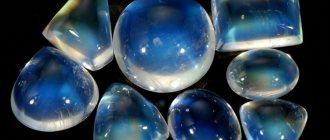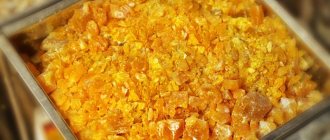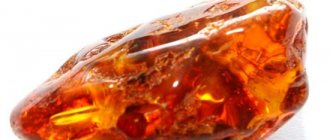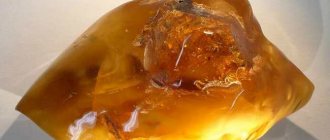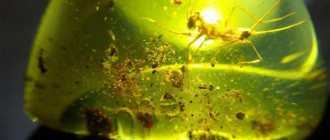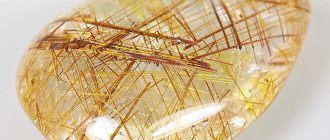At all times - even when amber was really cheap - the fossil resin of ancient conifers was counterfeited. Often out of simple interest in the process, even more often out of a desire to create something that rivals the beauty of nature’s creation. Today, when retail prices for amber products are off the charts, the interest of craftsmen is determined by the possibility of obtaining specific benefits.
A variety of natural and artificial materials are used, often not even outwardly very similar to natural amber. Let's take a closer look at the most common imitations of precious gems of organic origin...
dug
Copal is similar in origin to amber. Both are hardened tree resins. Only amber is the resin of the ancient conifers familiar to us, and copal is the secretion of plants of the legume group (which includes, for example, Robinia, which appears in our country as acacia) or exotic southern conifers, such as araucaria.
There is also a difference in age. Amber is tens of millions of years old. Copal is also a fossil, but its age sometimes does not exceed three million years - and in most cases it is barely 150-200 years old. Moreover: cutting certain plants of the tropical zone leads to the release of hardened resin, which after simple manipulations (mainly boiling or baking) is passed off as a copal fossil.
Visually, copal is difficult to distinguish from some varieties of amber. Processing of frozen drops of wood resin, carried out in autoclaves in the presence of various reagents, makes it possible to increase the hardness and density of fresh resin.
Particularly advantageous is the ability to introduce an insect into a drop of still liquid resinous deposits, allow it to take a natural “pose,” and then give the man-made product the appearance of a natural amber inclusion.
Belomorit
A delicate stone with an unusual color was found in North Karelia, where it got its name - belomorite in honor of the White Sea. Looking at the beauty of this gem, slowly turning it in different directions, we can enjoy the multi-colored tints. Highlights can be gray-blue, blue-blue and pale purple in color.
Belomorite is not very popular in folk medicine. It is difficult to talk about its pronounced medicinal properties. The only thing that can be confidently stated is that the mineral significantly disciplines its owner during the treatment process, helps him adhere to the medication schedule and monitors the conscientiousness of the implementation of treatment instructions. It is believed that belomorite can predict the occurrence of diseases. He encourages the owner to take preventive vaccinations or do health-improving exercises in order to prevent this or that disease. Belomorite evokes in its owner a desire for order, encourages him to bring cleanliness both in his home or office, and in his thoughts and head. Gives the necessary order in your personal life. Suitable for almost all zodiac signs. Only Leos and Geminis should avoid belomorite.
Cowrie resin
Kauri gum (or cowrie resin) is a substance related to copal, and had every chance of joining the triumphant procession of amber through the jewelry counters of the planet. This resin is produced by kauri trees, a type of coniferous araucaria. The history of cowries is venerable: these plants gave shelter to dinosaurs...
In case of damage to the root system, kauri trees produce a lot of oleoresin! A strong wind, swaying tall trunks, sometimes tears the roots - and then an impressive (up to half a ton!) deposit of resin forms in the ground under the tree.
However, the accumulation of resin wealth did not work out... The chemical composition of cowrie resin is only in general terms similar to the composition of amber - the same degree of similarity is observed with physical properties. Therefore, copal kauri gum is mostly used for the production of high-quality varnishes, and only in small quantities is it “modernized” by craftsmen for fake amber.
Kauri gum is usually classified as copal, despite the fact that the external resemblance of kauri gum to natural amber can be strikingly strong. In one of the museums in Auckland (New Zealand) there is an entire hall dedicated to cowrie gum. According to ordinary visitors, huge blocks of resin look exactly like amber!
Bernit
Bernite (or, in another reading, bernat) is sometimes passed off as natural amber. Although an array of bernite may contain 5% of actual amber dust, or may not contain it at all... Serious jewelry enterprises have long ceased to imitate natural amber with bernite: artificial stone is now painted in colors that are completely impossible for fossil resin, and is sold as a product that has independent value .
However, the synthetic polyester compounds that make up bernite completely imitate the optical properties of honey-clear amber. Special technologies for processing artificial “stone” make it possible to create defects in the massif—husks—that enhance the resemblance of burnite to amber.
The first bernites were produced by sintering amber powder with polyester resins. If the process took place in the presence of oxygen, the stone turned out yellowish-red. Heating in a nitrogen environment caused the bernite to turn green.
The range of bernites available today is so large and the colors so varied that bernite imitations of amber are vanishingly rare. Previously, there was simply no need for them! However, rising prices for natural amber may provoke an increase in the number of bernite fakes...
How to distinguish Buranite from amber
Buranite always has a pronounced emerald, sapphire or ruby color. There are no organic inclusions inside. It is medium-hard - 7 on the Mohs scale.
Amber is often marred by turbidity (see green amber). There is no blue and red palette in color. Natural resin can have a marsh or brown-green color without emerald tints. There are insects and plant parts inside. It is more easily damaged and becomes electrified when rubbed against wool.
Polyburn
It took almost a year for the chemists of the German Democratic Republic to fulfill the orders of the party and create a material that would make amber production waste-free. Amber chips formed during mechanical processing of natural stone became the basis for the production of polyburn.
Fixed with epoxy resin, small and hitherto inconspicuous pieces of amber sparkled, sparkled with light, and delighted with bright colors. The leadership of the Communist Party approved the innovation and industrial production of Polyburn began.
The Germans made up the name of the artificial stone from the names of the two main components of the material. “Poly-” is a reminder of the polyester resin that holds the pieces together. The syllable “-bern” is taken from the German name for amber – bernstein.
Mass production of polyburne allowed jewelers of the last century to produce several extensive series of jewelry - rings, pendants, brooches, earrings - with polyburne inserts. Interior items made of polyburn were also produced.
Soon, however, the fashion for inexpensive artificial stone passed. The jewelry quality of Polyburn strongly depended on the decorative quality of the amber fragments arriving at the enterprise. As a result, different batches of material differed from each other in artistic expression.
In such conditions, it was not possible to conduct rhythmic production of guaranteed quality stone. Enterprises switched to other products, but the technology was not forgotten. These days, several East German (and a few more Western European) laboratories produce polyburn in small batches.
Aragonite
The delicate mineral aragonite can be purple, white or light green. There are samples of blue and even black colors. The stone received its name in honor of Spanish Aragon, where it was found. Lithotherapists use an unusual mineral most often to treat the reproductive system. It is believed that aragonite can cure impotence or frigidity, and increase the sexual activity of its owner. The stone is also used to combat sexually transmitted or inflammatory diseases of the genital organs in men and women. In addition to these functions, aragonite copes with insomnia, helps relieve fatigue, tension, and eliminates the consequences of long hard work or stress.
A gentle pebble brings comfort and warmth to your home. He tries to instill an atmosphere of friendliness and comfort. Aragonite can rightfully be considered a family stone.
. In case of any aggravation of family relations, it is recommended to have something made from this mineral in the house. It will not only eliminate an unexpected conflict, but will also allow you to remember all the long-forgotten warm and strong feelings. The stone helps in raising children, and also becomes a conciliatory thing for the mother-in-law and daughter-in-law. Astrologers talk about the zodiacal versatility of this mineral. The only “but”: only married girls or married men can wear aragonite.
Bakelite
Leo Backland, an American chemist of Belgian origin, was a man who dreamed of success from a young age. However, the fame that phenol treated with formaldehyde brought him came from an unexpected place. Backland did not create Bakelite to falsify amber! But Europe disposed of its native’s invention in its own way...
It was not surprising that the world's first entirely synthetic plastic, suitable for mass production, was used for the manufacture of parts, cases and casings of all kinds of apparatus and instruments. Bakelite plastic went into electrical engineering and mechanical engineering, became getinax and textolite, brake pads and friction linings, adhesives and varnishes. However, in Backland's beloved Germany, his chemical brainchild, Bakelite, found a new application. The fact is that after the First World War the country became extremely poor. People didn’t have the money to buy precious stones and jewelry, but German women really wanted to be beautiful... It was for them that artificial amber, made from colored and tinted bakelite, was synthesized! The material turned out to be extremely responsive to the efforts of the production workers. By its nature, phenol-formaldehyde resin is colorless, but the introduction of impurities and small changes in the technological process make it yellow. Amber yellow! In general, businessmen only needed to take a few small steps - and the market in Germany, and after it in all European countries, was filled with “amber” beads, clips and rings made of Bakelite. The trend has been picked up by manufacturers of expensive pens. Today, more than a hundred years after the invention of Bakelite, Parker uses the fossil resin-like material in the production of its products. Nowadays, beads made of Bakelite, which imitates amber, are also produced - albeit in small batches. However, it is not easy to confuse natural stone and synthetic material...
Faturan
Confusion arose with faturan, an old and well-deserved material. The fact is that faturan is old and has many faces...
The invention of faturan occurred in the ΧVΙΙΙ century. Eastern craftsmen took waste from jewelry processing of amber (dust and shavings), resin from local plants; the products were mixed, heated, pressed - and the result was faturan. The skill of the artisans turned out to be so high that faturan beads instantly became money, equivalent to coins in circulation. Matte shiny honey-red beads still make an indelible impression today. However, the three-hundred-year-old recipe has been lost, and it is not possible to restore authentic production. Everyone thought so, except for Dr. Thrawn, a Hamburg entrepreneur at the beginning of the last century. Seeing the high commercial potential in bakelite, Thrawn decided to slightly modify the technological process and pass off minimally modified (simply tinted) bakelite as faturan, beloved by the East. The scam was a success. Until the early 40s of the 19th century, Thrawn's company was supplying new-made faturan to the Middle East. Transit was carried out through Turkey. The product penetrated into all countries of Western Asia. Inspired by Thrawn's success, modern scammers continue their criminal experiments and try to imitate both natural amber and ancient faturan by mixing who knows what synthetic ingredients. At the same time, everyone unanimously calls their crafts faturan. Neither Dr. Thrawn's bakelite nor the crafts of our day have anything to do with the ancient faturan that has become precious. And faturan itself (even the most real one) is very indirectly related to amber...
Benitoite
The mineral benitoite received its name in honor of the Californian area of San Benito, where it was found in 1906. At first it was confused with sapphire, and therefore was sold as this gem for a long time. Today, benitoite is an independent mineral and is the official stone of the state of California. You can find minerals with dark blue and light blue colors. Lithotherapists say that benitoite can control the psyche of its owner. It is widely used to treat nervous diseases, hysteria, seizures and excessive irritability. In addition to the nervous system, the mineral can treat diseases of the gallbladder, stomach, thyroid gland and intestines. Benitoite has a wide range of magical properties. It adds charm to its owner, thereby allowing him to reach the top of his career. The mineral also helps in your personal life. The stone will allow even the most desperate bachelor to quickly find his soul mate
. In the zodiac, benitoite is suitable for Leo, Aries and Sagittarius.
Celluloid
Celluloid as we know it was invented in America in 1869. John Wesley Hiatt, who patented the name of the new material, sought to create a full-fledged replacement for ivory. However, his followers went further and managed to synthesize a material vaguely reminiscent of natural amber from camphor, nitrocellulose and colloidal dye. Celluloid imitating amber was used as a decorative cover for cutlery. Handles were molded from it. They were used to decorate various household products. Celluloid plates with a pseudo-amber texture are still produced today. In most cases, the color of such products is bright, flashy, and has nothing in common with a beautiful fossil stone. In modern conditions, the production of celluloid is limited: this material is extremely flammable, its use anywhere is considered unsafe. It’s not easy to stumble upon celluloid “amber” on the jewelry market...
Casein is the basis for the production of galalite
Casein is actually a milk protein. Chemists at the beginning of the 19th century tried to treat casein with formaldehyde, and as a result they obtained a resin suitable for industrial use. In the Soviet Union, which was prone to assigning its own name to everything under the sun, the new material was called galalite. The production of plastic from the milk protein casein was developed and organized in Germany in the first quarter of the last century. The Soviet government ordered the purchase of finished production from the Germans in 1925. The following year the plant produced its first products. The plastic mass was given the sonorous name “galalith”, from the Greek “gala” - milk, and “litos” - stone. The name took root only on the territory of the USSR. Abroad, this type of plastic was (and is) called casein, after the name of the main ingredient of the synthesis. Galalite production technologists quickly achieved a well-known variety of their products. Depending on the number of hydroxyl groups integrated into the artificial polymer molecule, the material turned out yellowish or brownish-red, translucent or completely impervious to light. Coloring additives made it possible to create a wide variety of imitations of natural materials. “Horny” combs, “mother-of-pearl” buttons, and “amber” beads were produced from galalite. Galalite plates, similar in color and texture to ivory, were used to make piano keys. Galalite “amber” often resembled certain varieties of genuine amber. However, it is difficult to confuse artificial material with fossil stone. Galalite is significantly heavier than amber. The synthetic substance has greater thermal conductivity: it is cooler to the touch. Industrial production of halalite in the Soviet Union was discontinued almost half a century ago. However, today's private workshops may well use technologies worked out in the past to produce fake amber. Casein is freely sold by dairy processing plants; there are no secrets in the methods of processing milk protein with formaldehyde...
Ways to check amber in a store
The main ways to check a product in a store are reduced to inspection, checking tactile qualities and assessing the cost. Most often, transparent samples are faked.
Opaque ones are initially of lower quality and are cheaper unless we are talking about unusual specimens, so the production of imitations is impractical.
Appearance
You can distinguish a fake by appearance using the following criteria:
- Inclusions. In imitation they may be completely absent or have an elongated shape. The latter is due to the low strength of the material used to make the fake. Due to this, air bubbles easily moved to the surface. Inclusions get stuck in amber. Air bubbles have a round shape, because due to their high density they cannot quickly move to the surface.
- Cracks and overflows. As the stone matures naturally, irregularities and chips appear. They occur when mineral builds up and layers shift. It is often possible to trace the boundaries of layers as a result of changes in the chemical composition of the materials. Counterfeits are either completely homogeneous or have overly pronounced transitions without layers or cracks.
- Hue. This mineral has pronounced honey, milky and dark brown colors, sometimes with admixtures of green or red. Amber can be bright, but it doesn't look unnatural. The fake contains flashy shades and impurities.
- Pattern shape. Natural samples have a chaotic internal pattern. You can see patterns in fakes.
A drop of amber.
Tactile sensations
Even at the first touch, natural stone feels warm to the touch. It heats up quickly in your hands, but also cools down just as quickly. Plastic and glass are cold. It is almost impossible to distinguish fakes made from resins using this criterion. They have a similar composition, so they resemble the original.
Inclusions
Jewelry with insects inside is often found on sale. Sometimes even small animals get caught in the resin. For example, birds or reptiles.
If an animal gets stuck in natural material, it begins to fight for life: it tries to reach its paws, push off with its wings, etc. As a result, it acquires an uncomfortable, sometimes unnatural, pose.
In the case of fakes, the pose of animals and insects is standard. If it is an ant, its paws are placed almost at the same distance, the body is completely straight, the head is not raised.
This is due to the fact that the animal is placed in the material after its death. There are occasional exceptions when an insect ends up in natural amber already dead, but such cases are rare.
Amber with frozen insects.
Price
The original is often more expensive than the fake. Its price reaches $20 per 1 g. The cost depends on the presence of inclusions and defects, the shape of the sample, the quality of its processing, color and degree of transparency.
The production of imitations is cheaper, and therefore their price is lower. However, sometimes sellers try to sell a fake at the price of the original, so you need to take all indicators into account.
Acrylic
Polymethyl methacrylate has been known for quite some time. This is quite ordinary organic glass, otherwise called plexiglass or simply acrylic. During the Second World War, transparent elements of aircraft cabins were made from plexiglass. Nowadays, bathtubs are made from milky-colored acrylic, and imitation amber is made from transparent plastic tinted the color of honey. You can mistake acrylic “amber” for real only from afar or in a photo. The artificiality of the material is too obvious. The hand-made nature of internal defects and inclusions is too noticeable. Acrylic is deliberately shiny, and the shape of its beads is perfectly standard. However, acrylic products can mislead an uninitiated person. Modern methods of making counterfeits sometimes achieve their goal. Acrylic “amber” - especially in photos and videos - looks not just like real, but like jewelry amber of exemplary quality. There have been cases of falsification of premium jewelry with acrylic. Copying models of famous designers, scammers exactly repeat the shape of gold and silver frames and simulate the expressiveness of an amber cabochon. Such counterfeits are advertised via the Internet and sold by mail. In the videos, amber-like acrylic and “samovar gold” look extremely presentable. The products also look good in kind - for a short time... However, the very first visit to the jeweler makes the situation clear: costume jewelry, even of particularly high quality, does not cost as much as natural amber in a gold frame.
Resolan and novolak
Resolan and novolak are the familiar bakelite, only with a different name. The controversy arose due to the reluctance of resourceful European entrepreneurs to buy a patent for the production of Bakelite. Moreover, they did not want to call their products the familiar name of an overseas chemist... After all, the public, as we know, is greedy for something new. Thus, the businessmen of the Old World, forgotten today, on the border of the 19th and 20th centuries decided to earn extra money on someone else’s intellectual property. Having adopted generally simple overseas technologies, they began to delight Europe with women's jewelry. And if bakelite, called resolan, made it possible to more or less reliably imitate natural amber, novolak was used in two ways. First, ordinary beads were molded from novolak. Secondly, phenol-formaldehyde resin was turned into a viscous liquid, coated with faceted plexiglass beads, and the crafts were sold as valuable novolac items. The business did not last very long, but a number of products have survived to this day. The good quality of novolak and resolan makes modern collectors pay a lot of money for rare fakes.
Properties and characteristics of the stone
The properties and characteristics of natural amber are reflected in the table.
| Color | Shine | Stroke color | Transparency | Hardness | Cleavage | Kink | Density | Refractive index of light | Melting temperature |
| Varies from light light yellow to dark brown, with admixtures of red and green, and almost colorless and white varieties. | Smolyanoy | White | Varies from almost completely transparent to opaque | 2-2.5 points; soft material, scratches even with nails if you apply force | Absent | In relatively young samples it is viscous and conchoidal; in older specimens it becomes fragile | May vary: average - 1.05-1.09 per cubic meter. cm, but there are samples with a density of up to 1.3 g per cubic meter. cm | 1,54 | Reaches +350…+380 °C |
Polyester
Polyester, a completely artificial substance, and natural amber, the ancient fossilized resin of coniferous trees, are chemical relatives. Both compounds are polyesters. Polyester alone is produced and consumed in thousands of tons (mostly in the form of fabrics), and amber is mined from sediments and is used mainly for admiration. The chemical similarity of substances often becomes the basis for the structural similarity of samples. It should be noted that polyester and amber can be so similar to each other in appearance that we have to talk not about likeness, but about copying. Fortunately for amber buyers, polyester fakes have not (yet) become widespread. One of the reasons is the absolute dominance of polyester on the market, which is only suitable for creating fibrous materials. Special reagents and high-pressure thermal units are required to convert industrial polyester into pseudo-amber. True, the similarity between real amber and polyester “amber” is limited to the optical properties of the materials. Polyester is lighter and warmer to the touch, and when heated (even in the hand) it emits a plastic smell. Yes, and swindlers and counterfeiters work today in a rather rude manner. The defects of natural stone they imitate in polyester cabochons and beads look deliberate, too artificial and catchy. However, nothing prevents artisans from hiring a talented designer and achieving higher professionalism...
Authenticity tests at home
At home, you can carry out several tests that will help you distinguish a fake with a greater degree of reliability. However, some of them can damage the stone.
It should be borne in mind that the physical properties of amber may coincide with resins, so one test will not be enough. It is advisable to carry out several checks and take other indicators into account. Sometimes it is possible to distinguish imitation only in laboratory conditions.
Using salt water
The method is used only if the stone does not have a frame. Most samples have low density, so they float in salt water. To carry out the test, prepare a solution of 8 tsp. salt and 200 ml of liquid.
The spice is completely dissolved in water, then the stone is lowered. Crafts made from bakelite, burnite and glass sink, while amber most often floats. If the mineral is large, take a large container and add as much salt as the water will take.
The test is not considered completely reliable. Some specimens are quite dense, so they sink even in salt water. The lightest samples float in tap liquid.
Real amber will float in salt water.
Electrification
Natural stone is highly susceptible to electrification. For this test you will need a piece of wool or silk. The mineral is rubbed hard against the cloth, then brought to the paper. Natural stone immediately attracts the material to itself.
Using this method, amber is distinguished from copal. It does not become electrified even with prolonged exposure. Plastic can also attract paper, but this ability is less pronounced. To distinguish it from a real mineral, you will need a verified sample or visual inspection.
Natural amber is highly electrified.
Smell when melting
The mineral does not have to be melted. You can rub it hard against your palm to raise the temperature of the stone. In this case, the natural mineral will have a light pine aroma.
The fake resin smells even without exposure to high temperatures. Copal imitations begin to adhere to the skin after heating. Glass fakes have no aroma. Plastic can smell bad.
Additionally, you can bring the product to the fire. Use, for example, a lighter. When it comes into contact with a flame, the natural material will begin to boil and ignite. Black smoke will appear.
Counterfeits are either insensitive to fire or melt much faster. However, this is a traumatic method that will ruin the decoration. An alternative is to use a hot needle.
It will also damage the surface, but the defect will be less pronounced. Upon contact, white smoke should emit from the natural stone and a resinous odor will appear.
Amber is subject to combustion.
Solvent test
Natural stone is more resistant to solvents. As the latter, you can use, for example, acetone. Soak a cotton pad in the liquid and apply it to the surface for 1-2 seconds.
You cannot keep the stone in the solvent for more than 3-5 seconds, as this will ruin its appearance. With short-term exposure, amber remains the same and does not change.
Imitations made from copal deteriorate greatly, their surface becomes dull, and irregularities appear. The color changes. When pressed amber comes into contact with a solvent, it becomes sticky.
Alcohol
Alcohol is used in the same way as a solvent. Some stones are resistant to acetone, but are destroyed when exposed to ethyl alcohol. Other minerals, on the contrary, are resistant to the latter reagent.
Chemical reagents
Alcohol and acetone belong to the list of chemical reagents. Additionally, you can use stearin or ethers. They greatly change the appearance and tactile sensations when interacting with stones.
The mineral may, for example, become cloudy. But the abuse of chemical reagents can also spoil the amber itself, so reagents are used with caution.
Testing with chemical reagents must be carried out with care so as not to damage the stone.
Ultraviolet
Amber has natural luminescent properties. Under the lamp, the mineral begins to glow blue, green, brownish or purple.
Counterfeits do not have luminescent qualities, so their hue does not change and there is no glow. The rays pass through the material without concentrating inside.
Additionally, under the lamp you can better see inclusions, inclusions and cracks. Natural stones contain wavy transitions. Air bubbles have clear boundaries. The glow is inhomogeneous.
Amber in ultraviolet light.
For a scratch
This method is traumatic, so people try to avoid its use. Using sharp objects, it is possible to identify imitations made of glass and plastic.
Amber is soft, so needles, nails and knives leave scratches on its surface. The edges of such a “wound” are torn and heterogeneous. Glass surfaces are not scratched by steel. The plastic can be damaged, but the scratch will be smooth, without torn edges.
Ambroid – pressed amber
The history of ambroid dates back to ancient times. The Romans, who came up with the idea of boiling amber in honey to give it a thicker color, undertook experiments in pressing softened fragments of stone - but the results did not satisfy them, and the attempts stopped.
The medieval Arabs achieved great success. The advent of modern times gave a surge of user interest in inexpensive amber jewelry. And in 1881, in Austria, truly successful trials were carried out in the manufacture of jewelry material from amber production waste. Heated and pressed sawdust of amber, with the proper skill of artisans, turns into a substance, like two peas in a pod, similar to opaque varieties of fossil resin. Subsequent cycles of heating-squeezing-cooling in various environments bring lightening of the ambroid, or vice versa, a thickening of its color and a decrease in transparency. The Soviet Union, which carried out large-scale mining of amber, developed technologies for pressing amber chips, hosted the products, and flooded the domestic market with cheap and high-quality ambroid products. So high quality that today Soviet ambroid is not considered a fake amber. Its status is that of a reduced grade gem. Despite the controversy of such a formulation, it should be recognized: ambroid consists 100% of fossil resin, petrified over millions of years in the ground (however, it has undergone changes by the will of man). Modern enterprises have further improved the production of ambroids. Finished products that have come out of the press in recent years are difficult to distinguish from natural amber. Air bubbles alone, elongated and deformed during the pressing process, indicate the artificial origin of the jewelry.
Inclusions
From time immemorial, the authenticity of amber was determined, among other things, by the presence of inclusions - biological remains sealed in living deposits millions of years ago. But who in childhood did not have fun drowning flies in candle stearin? Modern scammers continue children's games, and enthusiastically push flies, spiders, and even small reptiles into hardening synthetics.
The difference is sometimes subtle, but in most cases obvious. A spider or mosquito, captured by resin a hundred million years ago, has long lost its flesh and become translucent. Their body has disappeared! All that remained was a bleached (in most cases) chitinous cover, and the exact form of a creature that once lived on Earth. Inclusion in natural amber is 99.9% empty, cavity! Fakes, on the other hand, show resin-filled insects in all their pristine glory. Synthetic polymers often act as preservatives, and therefore the blowfly, “packed” in resin two hundred years ago, looks as if it were alive – and also has a shiny blue-green cover! Artificial inclusions also reveal themselves as unnatural objects. The insect, having stuck to the resin, remains intact. Tweezers and other craft tools are crude and often strip mosquitoes of their wings or legs. However, on the market for geological rarities and amber jewelry there are many fakes that are almost indistinguishable from the genuine stone. Are artificial resins determined by spectrometers? Fraudsters - in light of the current increase in amber prices - are hastily purchasing hardened araucaria resin from the Southern Hemisphere, melting it, and placing not only insects and spiders, but also small reptiles and even exotic mollusks into castings. Classifying fakes as rare inclusions, hired propagandists convince collectors to purchase “amber” before representatives of wealthy museums arrive. “Such exhibits,” the tempters whisper, “are not even in the natural history museums of London and New York!” And the unlucky buyer who signs an order for a multi-thousand-dollar payment has no idea that this is because museums are not interested in forgeries! Amber counterfeiters are expanding their arsenal of criminal techniques and improving their ability to deceive. The latest trend in the market is the passing off of initially inexpensive, but modified and “improved” copals as amber. Amateur chemists are not asleep either. Artificial resins and even composites are increasingly taking on the appearance of amber - a silent witness of time immemorial, the eternal symbol of the Sun, an ancient friend of man and humanity.
Natural amber can be purchased in our store.

